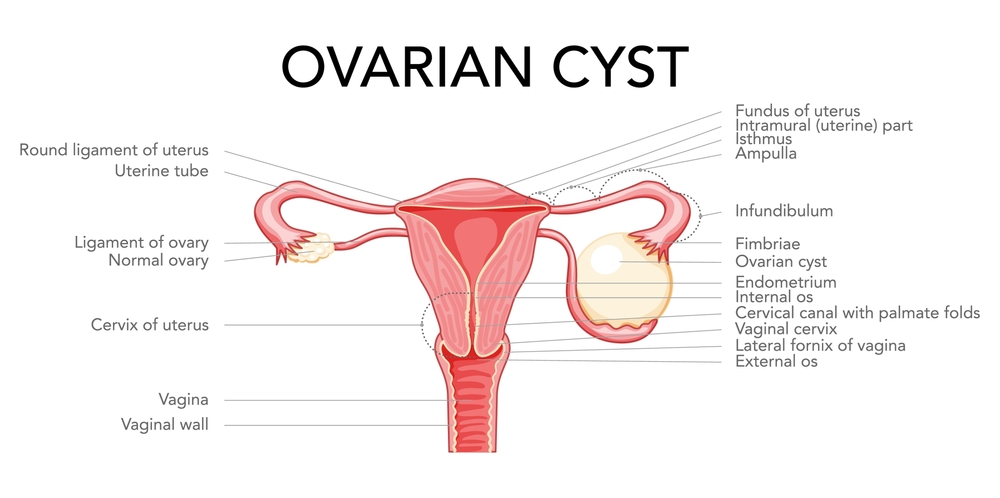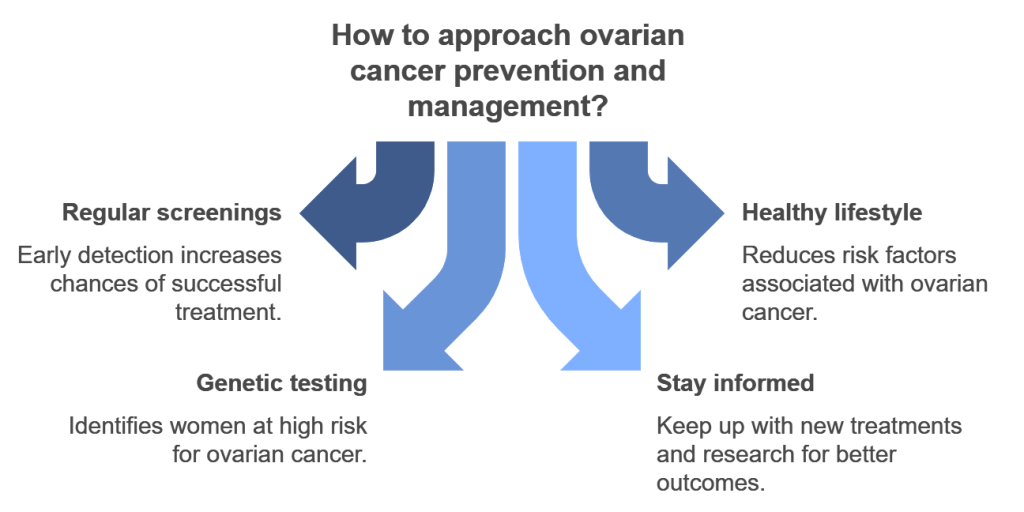What Is Ovarian Cancer?
Ovarian cancer is a type of cancer that begins in the female reproductive organ ovaries. The ovaries are responsible for producing eggs and the hormones estrogen and progesterone. When the ovary’s normal cells grow into abnormal cells uncontrollably and form a tumor, it can spread to other body parts.
Ovarian cancer is often difficult to detect in its early stages because symptoms can be vague for different conditions.

Symptoms and Early Signs of Ovarian Cancer
- Early-stage ovarian cancer may not cause noticeable symptoms.
- Common signs to look out for include:
- Bloating
- Pain in the lower belly or pelvis
- Feeling full quickly after eating
- Frequent urination.
Other signs may include-
- fatigue,
- back pain,
- changes in bowel habits, and
- unexplained weight loss or gain.
Causes of Ovarian Cancer
➡️ The exact cause of ovarian cancer is unknown, but some factors can increase the risk of developing it.
➡️ It starts when cells in or near the ovaries change or get damaged in their DNA. DNA acts like a set of instructions for cells, telling them how to function. The changes make cells grow and multiply quickly, forming a lump (tumor) of cancer cells.
➡️ Unlike healthy cells, these cancer cells don’t die when they should.
➡️ The cancer cells can spread into nearby tissues and travel to other parts of the body.
Stages of Ovarian Cancer

Stage 1: Early-stage ovarian cancer.
➡️ At this point, the cancer is limited to one or both ovaries. It may or may not affect the outer surface of the ovaries.
➡️ Surgery is often used to remove the tumor, followed by chemotherapy to kill any remaining cancer cells.
Stage 2: Localized spread.
➡️ Cancer has spread to nearby pelvic organs, such as the uterus or fallopian tubes, but it remains in the pelvis.
➡️ Surgery and chemotherapy are typically used in combination to treat the condition. The extent of the spread determines the type of surgery performed.
Stage 3: Regional spread.
➡️ Stage 3 ovarian cancer means that the cancer has spread beyond the pelvis to the lining of the abdomen or nearby lymph nodes. This stage is usually treated with chemotherapy.
➡️ The goal is to remove as much of the tumor as possible through a procedure known as debulking surgery.
Stage 4: Advanced ovarian cancer.
➡️ Stage 4 ovarian cancer is spreading to distant organs like the liver and lungs.
➡️ In this stage, patients may receive surgery, chemotherapy, and targeted therapies to manage the disease.
➡️ While a cure may not be possible, treatment can help control symptoms and increase life expectancy.
Diagnostic Techniques for Ovarian Cancer
Imaging Tests (Ultrasound, CT, MRI)
- Imaging tests such as ultrasound, computed tomography (CT), and magnetic resonance imaging (MRI) help visualize the ovaries and any abnormalities within them.
- These studies can describe the size, shape, and location of a tumor.
- Imaging with ultrasound is commonly used as an initial assessment, while MRI or CT scans may be ordered for further details.
Blood Tests (CA-125)
- Blood tests, especially the CA-125 test, measure the level of a protein that is often elevated in women with ovarian cancer.
- An elevated CA-125 level is specific in other conditions, such as endometriosis or pelvic inflammatory disease.
- Other blood tests may be used in conjunction to support the diagnosis.
Biopsy and Histopathology
- A biopsy involves removing a sample of tissue from the tumor for examination under a microscope called histopathology.
- It helps to confirm the diagnosis of ovarian cancer and determine the type of cancer cells involved. The biopsy can be done through surgery.
Treatment of Ovarian Cancer
Surgery: Types and Procedures
Surgery is considered the first line of treatment for ovarian cancer aiming to remove as much of the tumor as possible. Depending on the extent of the cancer, surgical procedures may include:
- Total Hysterectomy: This is the removal of the uterus.
- Bilateral Salpingo-Oophorectomy: Removal of both ovaries and fallopian tubes.
- Omentectomy: This is the removal of the omentum, visceral tissue in the abdomen commonly affected by ovarian cancer.
Surgery for Debulking: Removal of the greatest quantity of tumor tissue-which is especially done in advanced stages.
The surgeons may also remove affected tissues in the abdomen.
If the tumor is small, a minimally invasive surgery can be done called laparoscopy. The type and extent of surgery are determined by the stage and diffusion of cancer.
Chemotherapy: Drugs and Treatment Plans
Chemotherapy is a treatment that uses drugs to kill or prevent cancer cells from growing.
Before Surgery: It is used for the reduction of a tumor and thus enhancing surgical outcomes.
After Surgery: To destroy remaining cancer cells, which might have been left behind and couldn’t be removed during surgery.
For Recurrent Ovarian Cancer: This helps in the control of disease in cases of recurrence.
Chemotherapy Medications
- The most common chemotherapy drugs administered in the treatment of ovarian cancer are carboplatin and paclitaxel. Side effects generally include nausea, fatigue, and hair loss.
- Though these side effects can be serious, they are usually temporary and can be reduced by medication and supportive care.
Targeted Therapy: New Advances
Targeted therapies are treatments that target specific molecules involved in the growth of cancer cells.
Targeted drug example, PARP inhibitors are used to treat ovarian cancer by blocking proteins of cancer cells.
It boosts the body’s immunity to counteract the cancerous disease.
- Radiotherapy: When It’s Used
Radiotherapy is used in selected cases to attack particular regions of the body where dissemination has taken place.It uses high-energy rays to kill the cancer cells and shrink the tumor size.
2. Hormone Therapy in Certain Cases
Hormonal treatment can be performed in hormone-sensitive ovarian cancers. Tamoxifen and aromatase inhibitors reduce the levels of hormones that promote growth in cancerous cells.
New and developing treatments
The treatment for ovarian cancer changes frequently and is highly specialized. New therapies are continually being devised to improve survival rates and reduce side effects. Some therapies being researched or developed include:
- PARP inhibitors: These are medications targeting cancers with particular genetic changes, such as BRCA
- Immunotherapy. Treatment that enables the immune system to detect and destroy cancerous cells.
- Clinical Trails: This has access to new treatments currently in the research process.
These new options offer hope, especially to patients who have not responded to conventional treatments.
Read more: can-immunotherapy-cure-stage-4-cancer
Cost of Treatment for Ovarian Cancer
The cost of treatment varies significantly with the type of therapy duration applied and geographic location. It is crucial to familiarize yourself with possible costs for planning purposes.
Alternative Approaches and Supportive Care
Though traditional therapies are most effective, some look into other alternative options to supplement their course of treatment. Some of these include:
Nutritional therapy: Helps with a proper diet to keep the body as healthy as possible.
Acupuncture: Helps in pain and nausea associated with chemotherapy.
Herbal supplements: Must be taken with caution and under the careful eye of a doctor.
Symptoms, and supportive care, including physical rehabilitation and psychology-related interventions, are equally important to help in coping and enhancing quality of life.

Side Effects
Cancer treatments may have associated side effects, but there are ways to manage the associated side effects. Example symptoms include:
- Nausea and vomiting: Anti-nausea medications can help.
- Fatigue: Rest and light exercises can help alleviate symptoms.
- Hair Loss: Wigs, hats, and scarves can help with body image issues.
Open communication with the medical team will ensure symptoms are treated appropriately.
Prognosis and survival rates
The prognosis of ovarian cancer is heavily influenced by the stage at which it is diagnosed as well as the efficacy of the treatment method chosen.
In general, early detection leads to better prognoses, whereas advanced-stage cancers can have a worse prognosis but are still treatable with effective treatment modalities.
